
Atlas F1 Contributing Writer
Richie Ginther was not the biggest nor the best driver in Formula One in the 1960s, but he achieved something no one else did: he was the first driver to win a Formula One Grand Prix for the Japanese marque Honda. The Californian, whose motorsport interest and skills flourished after working with Phil Hill, was not only a quick driver but technically adept as well. Doug Nye writes about the man
Let's clear one thing up straight away. Paul Richard Ginther was known universally as 'Richie', and that's 'Richie' spelled just like that, without a 't'. Through 1965-66 he was Honda's number one driver after three seasons as Graham Hill's number two driver in the British BRM team, and after two preceding years spent as Ferrari's capo collaudatore - their chief test driver.
His Mexican GP win in the wonderful-sounding transverse-engined V12 Honda marked the high tide of little Richie's decidedly unusual Formula One career.
Peter Miller, in his fine book 'Men at the Wheel', related Richie Ginther's early career best:
"Educated at Santa Monica High School, Ginther was a keen engineering student and he had little time for academic studies, which bored him to tears. He was always passionately interested in cars and went without milk-shakes and movies for the whole of one summer in order to buy an old 1932 Chevrolet. In 1946, Richie's brother held a fraternity party and one of his guests was a schoolfriend of his, Phil Hill, who lived round the corner. Richie was introduced to Hill and nothing came of the meeting until a year later, when Richie helped Phil work on his MG. Ginther was fired by Hill's enthusiasm and readily admits that it was he who taught him about fast driving and turned him into a professional driver.
"In February, 1948, Ginther graduated and worked in the jig and tool division at Douglas Aircraft for the next 18 months. But he hated punching the time clock and the monotony and through Phil Hill's influence went to work with him at International Motors in California as a mechanic. Richie drifted into other jobs and in 1951 took a mechanic's job with Bill Cramer, a Californian motoring enthusiast. It was through him that he made his competition debut, driving the Cramer TC MG in the Sandberg Hill Climb Ridge Route.
"Ginther was inducted into the United States Army on August 5, 1951 (his 21st birthday) and spent the next two years repairing helicopters at an Aircraft and Engine Mechanic's School.
"His father died of a heart attack while he was away and when he came out of the Army in 1953, Ginther had to work hard to help the family. Then his old friend Phil Hill invited him to go as his passenger on the Pan-American road race and Richie had his first taste of real motor racing.
"On the second stage from Puebla to Mexico City, their Ferrari Mexico coupe shot off the road onto the rocks below and they crawled out of the wreck without injury (soon after they scrambled clear, two other cars crashed off the road at the same point - Phil Hill recalls: "That explained why a crowd had gathered there, even before we went off…").
"Undaunted, Ginther volunteered to go with Hill the following year and they came second in Allen Guiberson's Ferrari, only 20 seconds behind Maglioli's big works Ferrari.
"Ginther then worked in several imported car agencies and was able to drive a company-entered Austin-Healey in several regional races, In 1955, he went over to Le Mans as Phil Hill's mechanic in the Guiberson team, but after the terrible accident when 'Levegh's Mercedes went into the crowd, their plans to stay in Europe were curtailed and Ginther's continental debut was shelved for two years.
"Richie was then offered a drive by Johnnie von Neumann in a spare Porsche at Santa Barbara and took a third overall. Impressed by his talent, von Neumann gave him regular drives and a job in his Volkswagen and Ferrari agency and soon Ginther was manager of the biggest Ferrari importers in California.
"Through von Neumann, Joe Lubin, Johnnie Edgar and other wealthy patrons, Ginther got plenty of drives and rapidly made a name for himself on the west coast of America.
"In 1957, he was sent over to Le Mans by Luigi Chinetti, himself a triple Le Mans winner (1932, 1934 and 1949) and Ferrari's right-hand man in the States, but his Testa Rossa Ferrari went out after 10 hours. Later that year he won races at Lime Rock, Riverside and Torrey Pines, all in Ferraris. At Sebring the following March, he co-drove with von Neumann and although their Testa Rossa went out with a broken rear-axle they were third for most of the race.
"Ginther's fine drive did not go unnoticed and Chinetti passed the word to Maranello. In 1959, Ginther was top Ferrari driver in America and by that time he was making frequent trips to the factory in Italy on business. Once he did some testing on the Ferrari sports car but he refutes the story that he ever went over with the hope of getting a contract from the Commendatore.
"By the end of 1959, the strain of running the thriving Ferrari agency in California was getting him down and his nerves were in a shocking state. In January, 1960, he took a second place with von Trips in the Argentine 1,000 kms race and stayed on in South America for a month afterwards.
"It was then that he realised how unhappy he was and on his return he gave in his notice. He was at his lowest ebb mentally, when he had a telephone call from Ferrari offering him a contract for four races: the Targa Florio, the Nurburgring 1,000 kms, Le Mans and the Monaco GP. The money wasn't brilliant, but he badly needed a job and went over to Italy, taking his wife Jackie with him.
"In the Targa, his first appearance as a works driver, he skidded into a tree and reckons the accident did him a lot of good - discretion being the better part of valour! He made his Grand Prix debut at the Monaco GP where he drove impressively into sixth place in the prototype rear-engined Formula 1 Ferrari.
"Ginther was given bonus rides at Zandvoort and Monza, where he came sixth and second, and apart from his team duties took over the job of chief test driver.
"He was eminently suited for the role and, like Jack Brabham, quickly proved that he was an engineer who could really drive a racing car.
"He played a vital part in the development of the rear-engined Formula 1 cars which were to give Phil Hill the championship in 1961 and his understanding of Carlo Chiti, the bulky Tuscan designer, did much to smooth out the considerable internal conflict at the factory.
"Living at Modena opened up an entirely new way of life for Richie and Jackie - and their dachshund 'Puck'. The Ginthers came to appreciate European food and wines and took a great interest in history and the arts."
(Nye: Phil recalls Richie struggling with the language. They'd done a deal with a local Modenese restaurateur to pay a fixed sum a month in return for as much as they wanted to eat. Richie insisted on ordering the meal in his best acquired Italian. The staff collapsed in hysterics - 'Richie'd ordered his grandmother with tyres…!').
"Ginther's contract with Ferrari was renewed in 1961 and he drove with great determination, finishing fifth in the Championship table with 16 points. He gave an example of his love of machinery at the French GP, when he made a hurried pit stop while in the lead to report falling oil pressure. Team manager Tavoni told him to continue, but Richie pulled off the circuit half a lap later to save the engine. After the race he said, 'I won't endorse abusing a car in order to win'.
"Ginther was delighted when his friend Phil Hill became World Champion at Monza, but was deeply shocked over the death of von Trips, whom he admired greatly.
"At the end of the year, Ginther was surprisingly dropped from the Ferrari équipe and replaced as a test driver by the Belgian, Willy Mairesse.
"But Ferrari's loss was BRM's gain, for Ginther signed with the Bourne team as No. 2 to Graham Hill for the 1962 season…."
The sandy-haired little Californian had been sounded out to move from Ferrari. He was not only keen to earn some real money at last, he was also ideal for what BRM really required; a technically adept and experienced test driver who could also - plainly - perform in public on the Formula One World Championship stage. But the question of established number one racing driver, and potential works team number two, was far from settled, even if Ginther would agree to move from Emilia to Lincolnshire.
It came as a tremendous relief when Richie Ginther finally arrived fresh from his former employ at Maranello and provided a precise Ferrari power curve. Cadet BRM driver/go-for Bruce Johnstone was detailed to look after Richie Ginther upon his arrival, and took him up to the test house at Folkingham to witness running there. He was interested by what he found, but not particularly impressed relative to the series of engine test cells howling away at Maranello every day. At last, his first new V8 BRM was ready and he test drove it at Witham Aerodrome. His introduction to BRM that day was simply catastrophic…
A young apprentice mechanic, Alan Challis, was there that day: "There was a third of a mile straight there, we saw him come into view out of the top corner already alight and as he nearly got it stopped he stood up in the seat and jumped and the car stopped about 30 yards from us. His overalls were alight up the back…".
Chief engineer and team manager Tony Rudd: "…instead of switching off, which would have completely cut off the flow of fuel at 7-Bar and probably extinguished the fire, he steered the car in so we could deal with it, and was badly burned because he did so".
As Richie sprang, burning, from the cockpit, Arthur Hill, the ex-Tank Corps sergeant mechanic, rugby-tackled him and smothered the flames with his own body.
Tony doused the fire in the car's engine bay with a big extinguisher, and as Dennis 'Sheriff' Perkins, the team's ace lap charter and gearbox specialist had just driven up, Tony wrapped Richie in his overcoat, bundled him into 'Sheriff's brand new Triumph and rushed him direct to Stamford Hospital - which coincidentally had a fine burns unit.
Richie was admitted, heavily sedated, and although the burns specialist advised that skin grafts would probably not be necessary, he spoke of two to three weeks confined to bed. BRM's chief executives, Sir Alfred Owen, his sister Jean and her husband Louis Stanley streamed in to see the unlucky little American. Team mechanic John Sismey and his wife also visited Richie, recalling: "He said 'Thank God it happened in front of you British mechanics - if it had happened at Ferrari the Italians would all have run away. You guys ran towards me!"
He was back in the cockpit at Easter Monday Goodwood but hadn't got the hang of restarting his fuel-injected V8 when warm, and at May Silverstone for the non-Championship International Trophy he hit an unexpected puddle on a drying track and crashed heavily, writing off the car built to replace the original destroyed by the Witham fire. In the Dutch GP he spun off in a collision with Trevor Taylor's second-string works Lotus, and at Monaco his car's throttle jammed open entering the first corner, and so he clattered his way through the front end of the pack, taking out several other cars before smashing heavily into the bale barrier. Tragically, his car's right-rear wheel was torn off and struck and killed a track marshal.
Little Richie was a sensitive man. His first few races with BRM had been little short of disastrous. He was hurt, and missing his wife Jackie who was home in California. A devout Catholic, she was already in agonies over her husband's profession - so gratuitously willing to risk his gift from God… his life.
He bounced back in practice for the non-Championship Oulton Park Gold Cup, qualifying on pole. As mechanic John Sismey stood with him on the grid: "As we waited for the start with the car on pole position, a journalist who should have known better came up all excited and said to Richie 'Cor, did you see that accident in the last race, fantastic mess - it's really dangerous out there…' - and as he moved on little Richie turned to me and said 'Jahn - isn't it amazing what world-class assholes you meet in motor racing?"
The BRM team went to the Italian GP more confident than at any time in their history. Graham Hill had won the Dutch and German GPs in their cars, and now Richie was beginning to come on song after his distressing start. The little man was desperate to do well upon his return to Ferrari's stamping ground. He chose to drive the team's latest 'Lightweight' car, tailored to Graham Hill's much taller form. The mechanics padded him forward in the cockpit with sorbo rubber, and adjusted the pedals as far forward as possible. The car was crammed with fuel, as was Graham's. And in the race both raced perfectly - Graham first, Richie second - BRM dominantly 1-2, Ferrari utterly crushed. The tifosi had it in their hearts to cheer for 'Geentah!!!' - he was overjoyed, fulfilled, perhaps vindicated…
In his home GP at Watkins Glen it was a different story. His engine failed. Over to South Africa in preparation for the Championship-deciding last GP of the season, and there were two preceding non-title races. Richie won his heat of the Natal GP at Westmead, his maiden F1 victory. In the final he was beaten by the Team Lotus twins - Clark and Taylor - in Lotus 25s. At East London in practice for the decisive South African Grand Prix his car briefly caught fire in the pits. Richie erupted from the cockpit, cleared the windscreen in one brisk leap and ran straight down the car's magnesium-elektron nose - he was so light he didn't even dent it. He finished seventh the next day - Graham and BRM became World Champions.
Through 1963, Richie's role continued as second-string to his British team leader, but a highly-valued asset more as a development and test driver than racer, although his race performances were great for a number two - any modern team would have loved such success from their back-up driver. He placed fourth in the Aintree '200', then a fine second to Graham's victorious sister car at Monaco - nothing wrong there, no question of him not doing justice to car and team. Richie: "When I noticed the TV helicopter following something just out of my sight round the lap, I figured that must be Graham - so I rolled it off, not to pressure him…and to make sure we'd nurse both our cars home to the finish"… Richie Ginther, team player.
For 1964, new monocoque-chassised BRMs emerged. Richie loved the cars and the notion of competing against the less sophisticated Lotus versions driven by Clark and Arundell. But his performances in the cars would not quite fulfil BRM's expectations. They thought his results failed to do their cars justice. Still the season started for him with a most unsettling crash during practice at Aintree, when he went off on the high-speed Melling Crossing, cartwheeled off a ditch and slithered inverted across an infield lawn. He was winkled out from beneath his new car with a broken collarbone and concussion and was deeply shocked.
Still he bounced back to finished second (again) to Graham at Monaco in a repeat BRM 1-2. He placed fourth at Spa, fifth at Rouen, second - thanks to simple survival - in the rough-road race at Zeltweg, Austria, then fourth at Monza and Watkins Glen. He test drove the new Rover-BRM gas turbine for Le Mans, but engine difficulties and a transporter crash saw the race entry scratched there that June. Richie was invited to drive instead for Ford Advanced Vehicles in their startling new Ford GT. He shone - especially in the Reims 12 Hours where he lapped like a rocket in the high-oxygen chill of night, hammering at a probably genuine 200mph down the narrow Soissons Straight, by lamplight…
Richie was told by BRM that his contract would not be renewed for 1965. Yoshio Nakamura of Honda snapped him up instead - a technically adept driver, experienced and capable, a receptive mind jampacked with rival team detail… he was ideal for the Japanese. Little Richie liked them and they liked him. It took a while - a long while - for Honda's engineers to appreciate that motor races are won on the circuit, not on the engine-test dynamometer, and Richie fought long and hard to convince them that driveability would triumph over sheer peak horsepower.
Into 1966, the little man drove for Cooper-Maserati, pending completion of Honda's new 3 litre Formula One car. With the British team, Richie struggled. The car was hefty, its Italian V12 engine thirsty. It required muscle to drive it, and he was fit but small and overpowered. He covered fifth greatest distance at Monaco, but broke a driveshaft before the finish. He placed fifth at Spa, where the field was depleted by a massive lap one disaster, then returned to Honda to give the new longitudinally-mounted 3 litre V12-engined car its debut at Monza. He survived an enormous shunt, hurtling off course in the Curva Grande and collecting a tree side-on, in the cockpit.
He was badly shaken, and broke minor bones, yet raced again at Watkins Glen, and placed fourth in Mexico. His friend Dan Gurney invited him to join the new AAR Eagle team for 1967. Richie shone in early outings, such as the Brands Hatch Race of Champions, and with Dan winning and Richie third, this was fun - like old days - the Californian boys, little and large, strutting their stuff. He tried his hand at Indy. It was quick and that concrete wall flashed by awful close… like watching that tree rush up at Monza.
He would return to racing, running Porsche endurance teams, and visiting the German GP at Hockenheim, but he kept the old activity at arm's length thereafter. He sold his modest US business, bought a motorhome and spent long months touring, especially in Mexico, some of the time with his son Bret. He found a new life partner in Cleo von Neumann, divorced from John von Neumann, and later they shared a lovely beachside home in Baja.
He was persuaded to return to the cockpit of a BRM for the filming of a documentary to celebrate BRM's 40th anniversary in 1989. His old teammates and chums there were shocked by his appearance. He was all too evidently a desperately sick man. One stuttering lap in the BRM was really enough. Cleo took him off to France to recuperate. In desperate condition with a major cardiac problem, he suffered a massive heart attack and died suddenly - in France - on September 20, 1989.
Little Richie Ginther had been another of those motor sportsmen who probably never appreciated - nor believed - just how many friends he'd made on the other side of those spectator fences. More than his old friends and colleagues mourned him.
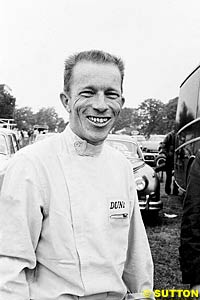 Richie Ginther was the smallest worthwhile driver in Grand Prix racing during the 1960s. The freckle-faced little Californian stood about 5 foot 6 inches tall and weighed 130 pounds. There wasn't much of him, but as Honda's number one driver he scored their first ever Formula One World Championship-qualifying Grand Prix victory, when he won the 1965 Mexican GP - the grand finale of 1½-litre Formula One's five season life.
Richie Ginther was the smallest worthwhile driver in Grand Prix racing during the 1960s. The freckle-faced little Californian stood about 5 foot 6 inches tall and weighed 130 pounds. There wasn't much of him, but as Honda's number one driver he scored their first ever Formula One World Championship-qualifying Grand Prix victory, when he won the 1965 Mexican GP - the grand finale of 1½-litre Formula One's five season life.
"Paul Richard Ginther was born in Hollywood, California, on August 5, 1930, the younger son of an aircraft worker at Douglas. His brother, George, was born on July 7, 1927 and sister, Bonnie, on June 13, 1928. Shortly after Richie's birth, the family moved to Dayton, Ohio and lived there until 1935, when they headed back west to Santa Monica, California.
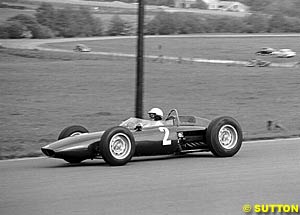 He'd covered a few laps, acclimatising himself to both the car and the makeshift aerodrome test track when he felt, first, a chill spray of volatile fluid against his neck, then a searing furnace blast of heat; a banjo-coupling on engine 5604's injection had worked loose, the escaping high-pressure fuel spray had ignited, and at speed little Richie was in desperate trouble.
He'd covered a few laps, acclimatising himself to both the car and the makeshift aerodrome test track when he felt, first, a chill spray of volatile fluid against his neck, then a searing furnace blast of heat; a banjo-coupling on engine 5604's injection had worked loose, the escaping high-pressure fuel spray had ignited, and at speed little Richie was in desperate trouble.
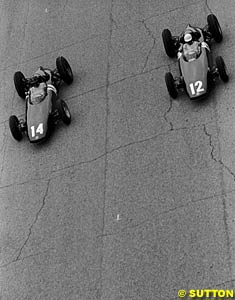 But he stuck to his profession. Jackie joined him in Europe, and he was happier - so was she… marginally. He was third in the French GP at Rouen - miraculously, after stalling at the start - while his Californian chum Dan Gurney (who towered tall above little Richie) won in the factory flat eight Porsche. His team expected him to excel on the Nurburgring - which in his Ferrari sports car career had been something of a specialist subject. He did not. They felt it… and so did he. The little man was cheerful, bright and chipper when things went well. But he could be short-fused, morose, introverted when they did not.
But he stuck to his profession. Jackie joined him in Europe, and he was happier - so was she… marginally. He was third in the French GP at Rouen - miraculously, after stalling at the start - while his Californian chum Dan Gurney (who towered tall above little Richie) won in the factory flat eight Porsche. His team expected him to excel on the Nurburgring - which in his Ferrari sports car career had been something of a specialist subject. He did not. They felt it… and so did he. The little man was cheerful, bright and chipper when things went well. But he could be short-fused, morose, introverted when they did not.
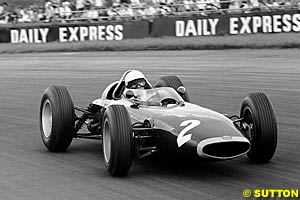 He then placed fourth in Belgium, fifth in Holland, fourth at Silverstone, third in Germany (not good enough - it was felt he should have won there), second (for the second consecutive year) at Monza, second in the Oulton Gold Cup, second in the US GP at The Glen, and third in Mexico City. Richie also played a major role in development of the Rover-BRM gas turbine roadster for Le Mans, and completed the race there, co-driving the 'whooshmobile' with Graham. He surprised his mechanics by asking them to fit a wooden block as a clutch-foot rest after the Rover-BRM had been lined-up for the Le Mans start. He could be demanding too.
He then placed fourth in Belgium, fifth in Holland, fourth at Silverstone, third in Germany (not good enough - it was felt he should have won there), second (for the second consecutive year) at Monza, second in the Oulton Gold Cup, second in the US GP at The Glen, and third in Mexico City. Richie also played a major role in development of the Rover-BRM gas turbine roadster for Le Mans, and completed the race there, co-driving the 'whooshmobile' with Graham. He surprised his mechanics by asking them to fit a wooden block as a clutch-foot rest after the Rover-BRM had been lined-up for the Le Mans start. He could be demanding too.
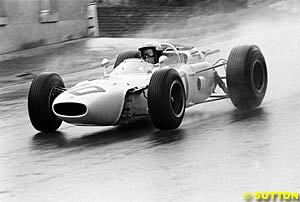 In 1965 he scored Honda's first point with sixth at Spa, and he led the initial charge off the line at Silverstone before the Honda V12 engine lost power as it heated up, a chronic complaint. He placed sixth again in Holland, seventh at The Glen… and then came the race at altitude in Mexico City. Richie's Honda blasted at Dan Gurney's overall legs as he walked behind it in the pits: "It was passing so much gas it was obvious that if that formula had run for another year we wouldn't have seen which way that Honda had gone!" Richie qualified third fastest, but led all 65 laps. Dan drove a tremendous race in his Brabham-Climax, but as he closed on the Honda in the final laps Richie did just enough to preserve his lead to the chequered flag. Grizzled experience was the key.
In 1965 he scored Honda's first point with sixth at Spa, and he led the initial charge off the line at Silverstone before the Honda V12 engine lost power as it heated up, a chronic complaint. He placed sixth again in Holland, seventh at The Glen… and then came the race at altitude in Mexico City. Richie's Honda blasted at Dan Gurney's overall legs as he walked behind it in the pits: "It was passing so much gas it was obvious that if that formula had run for another year we wouldn't have seen which way that Honda had gone!" Richie qualified third fastest, but led all 65 laps. Dan drove a tremendous race in his Brabham-Climax, but as he closed on the Honda in the final laps Richie did just enough to preserve his lead to the chequered flag. Grizzled experience was the key.
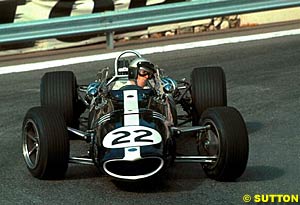 At home, life was difficult. Jackie was history - the marriage failed - he loved his son, life was difficult, Honda had not performed as he had hoped, now Dan was a true friend, he would never let a friend down, but life was difficult. In practice at Monaco he suddenly knew he just could not do this any more. Worse, he did not want to do this any more. He'd done enough, seen enough, risked enough. He wanted out. He confided in Dan, who respected his decision. Abruptly little Richie Ginther was a retired racing driver.
At home, life was difficult. Jackie was history - the marriage failed - he loved his son, life was difficult, Honda had not performed as he had hoped, now Dan was a true friend, he would never let a friend down, but life was difficult. In practice at Monaco he suddenly knew he just could not do this any more. Worse, he did not want to do this any more. He'd done enough, seen enough, risked enough. He wanted out. He confided in Dan, who respected his decision. Abruptly little Richie Ginther was a retired racing driver.
Please Contact Us for permission to republish this or any other material from Atlas F1.
|
Volume 9, Issue 36
Honda 250: Special Project
Interview with Jacques Villeneuve
Interview with Shoichi Tanaka
Interview with Jenson Button
House of the Rising Sun
Honda's First: Richie Ginther
Honda Through the Lens
Trading Cards: Honda's Drivers
The Honda Trivia Quiz
Columns
On the Road
Elsewhere in Racing
The Weekly Grapevine
> Homepage |
